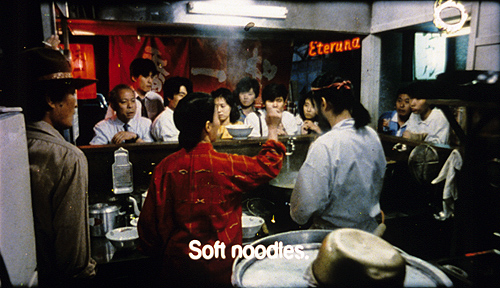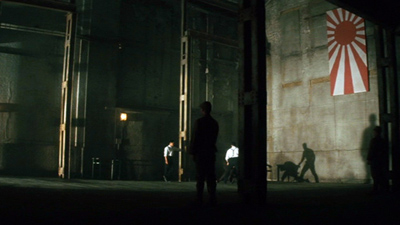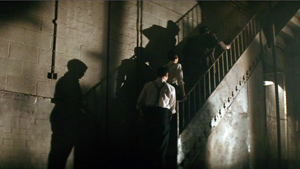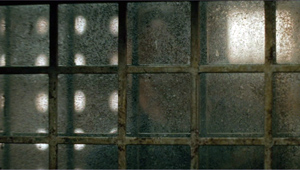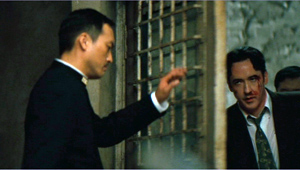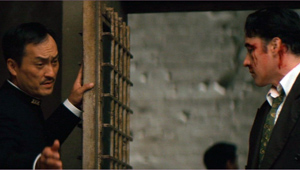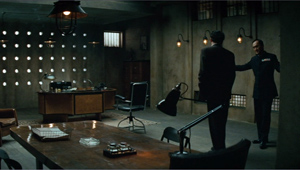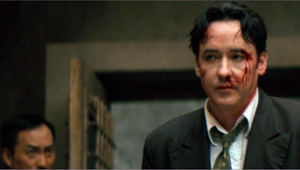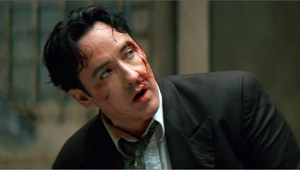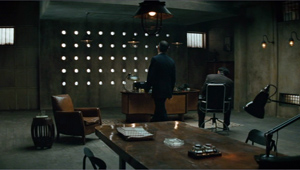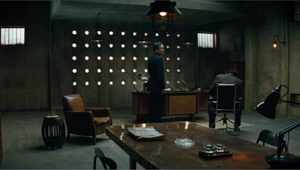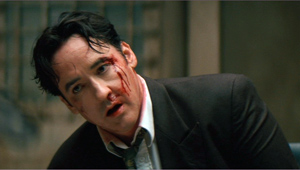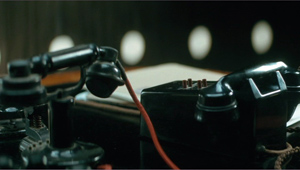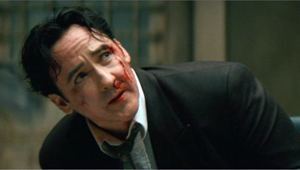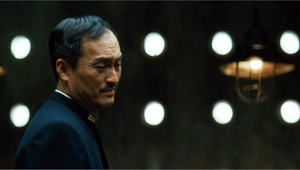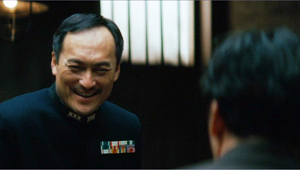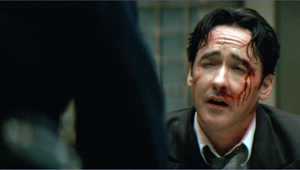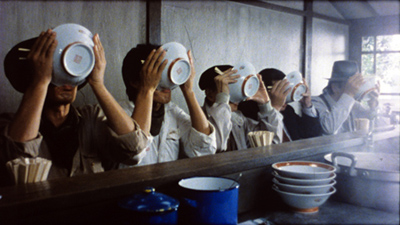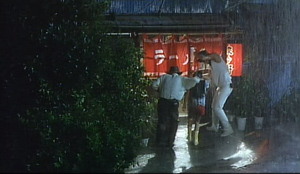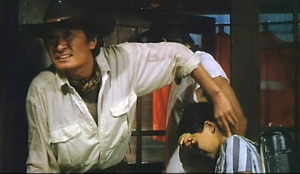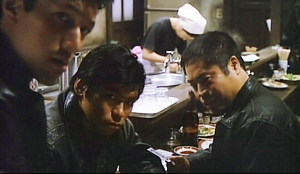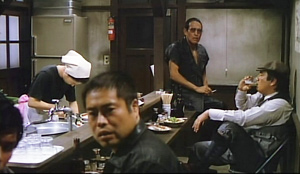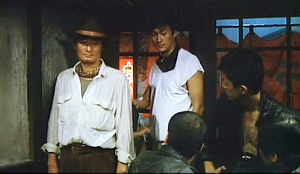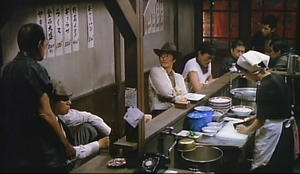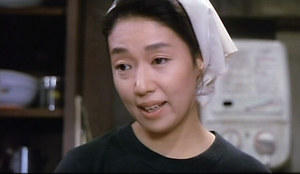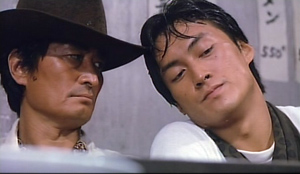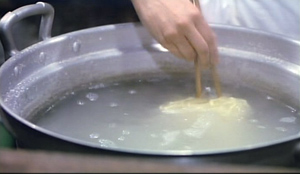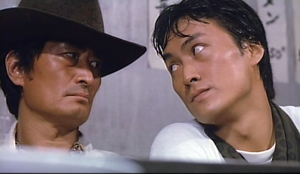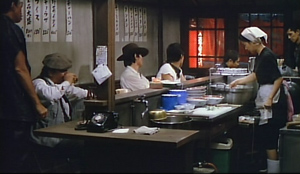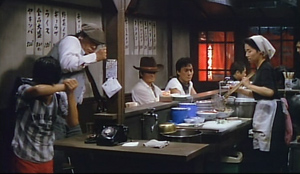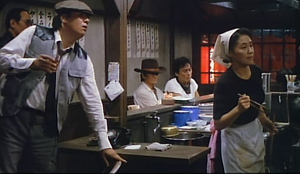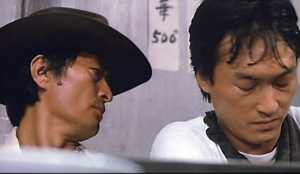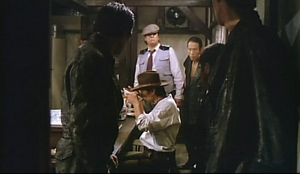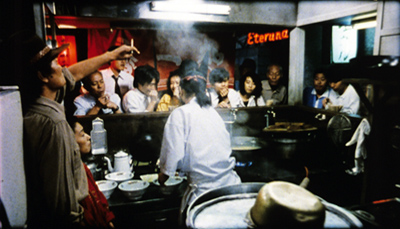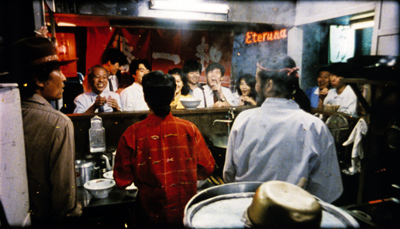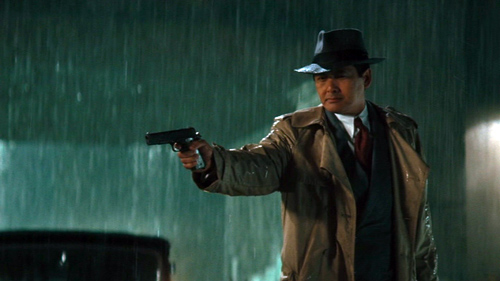Direction: Come in and sit down
Monday | January 3, 2011 open printable version
open printable version
Tampopo (1985).
There is what we call the Hollywood Style. . . . . Master shot [filmed] from the very beginning [of the scene] to the end, then a close shot from beginning to end, then from angles A and B, cutaways, et cetera. Then all of the materials are assembled later in the editing room. But in Japan, the editing plan is prepared before shooting. When you cut, it’s a matter of trimming heads and tails and just putting it together. Three days after the end of filming, there is a rough cut of the film.
Itami Juzo (The Funeral, A Taxing Woman).
DB here:
Planet Hong Kong 2 still on the way…. very close to ready…. deciding among cover designs…. soon; sooner if possible….
In the meantime, some creative choices involved in directing a simple scene.
Shanghai’d
What could be easier than getting a man into a room and sitting him down? The opening scene of Shanghai (2010) seems to me to bungle this basic piece of tradecraft.
In the image above, journalist and spy Paul Soames is being beaten up by the minions of Captain Tanaka. Who’s the poor sod who has to hang those big flags so high in movie torture chambers like this? Anyhow, soon the torturers drag Soames up the stairs, likewise in long shot, to meet the captain.
A brief shot of a door opening seems to put us in Soames’ shoes. But that viewpoint isn’t carried through consistently: we cut abruptly to the other side of the door, to a long-lens medium shot of Tanaka opening it.
Soames steps forward and is greeted by Tanaka.
Now comes the establishing shot, from quite far away, as Soames walks to the desk. This shot is interrupted by cutting back to the shot of Soames moving forward.
As the shot continues, Soames sits down and looks up. Throughout the scene, this setup will be assigned to cover Soames, with the camera panning and reframing as necessary.
Counting the swinging-door shot, it has taken four shots to get Soames into the room. But the actors aren’t yet fully in place. As Soames turns his head, Tanaka (back to master shot) moves around on Soames’ left side. The phone starts ringing.
Tanaka begins to halt at his desk, but before he stops moving we cut again to Soames, whose attention has shifted to the phone. He has asked that his embassy be notified, and now he suggests that it’s the embassy calling.
Cut to a close-up of the telephone, the object of Soames’ attention, and another shot of Soames, as before, as he looks expectantly back at Tanaka.
Now we have a closer shot of Tanaka, still slightly moving, and we catch his disdainful expression.
After Tanaka lifts and drops the receiver to cut off the call (another close-up), he settles into place. The rest of the conversation is played out in those loose over-the-shoulder shots that modern directors like so much.
Throughout, the shots of Soames seem to be from the same camera setup as when he entered. No repositioning of the camera marks stages of his part in the conversation, though at the end of the scene a pair of close-ups shows Tanaka asking, “Where is she, Mr. Soames?” Cue the flashback.
It’s not just that it took director Mikael Håfström over a dozen shots to get Soames and Tanaka into position for their central duet. Hitchcock might use several shots too. But each of his would be calibrated for specific expressive effects, such as subjective point-of-view treatment or a striking composition. Instead, the Shanghai shots exemplify a fairly casual cover-everything approach–a scattergun version of what Itami called the Hollywood Style.
Here the individual shots make a big deal out of a simple piece of business. We don’t need to see all of Tanaka’s office (since the rest of the space never gets used in the scene), and it doesn’t need to be so vast in the first place (except to announce that this is an expensive movie). The long-lens camera setup that lets Soames advance into the room and sit exists solely to let us watch the actor act, and it provides awkward cuts when bits of it are embedded in extreme long-shots.
It’s not hard to imagine alternatives. A straightforward tracking back from Soames as he enters and sits, framed from further away, would have kept both him and Tanaka in the frame. This framing could have easily shown Tanaka coming around to take up a position in the foreground by the desk, perhaps turned partly toward us so that we could peg him as a major character. Then if you insist on a cutaway to the ringing telephone, it would have had more impact, interrupting a sustained shot and contrasting to the fuller frame showing the two men.
Today many directors believe that we must always see the face of the person who’s speaking. So we get lots of shots, mostly singles, one per line, and each face is usually in close-up or medium-shot. Hence the great number of cuts per scene; here, counting from the swinging door, we get 23 shots in 97 seconds. And hence the repetitive reverse shots that cover the conversation.
I’m not the only one who notices these things. “If I see another over-the-shoulder shot,” says Steven Soderbergh, “I’m going to blow my brains out.”
Television probably has a lot to do with the emergence of this style, as some historians, me included, have argued. You have to be a good director to overcome the choppiness inherent in this manner of filming. I don’t think that Hafstrom did that. If the director had planned his shots in the finer-grained way Itami indicates, we might have had more visual variety, along with compositions and cutting that take us beyond the actors’ faces and line readings.
Dandelion soup
Now we might look at how Itami does it. An early scene of Tampopo (1985) also demands that a man, along with his sidekick, come into a room and sit down. We see Goro the trucker and his pal Gun enter the noodle shop, along with the little boy they’ve found lying on the street. We see them first from outside and then from inside the new locale, much as in our Shanghai example. But there’s no need for anything like that insert of the opening door.
Cut to a point-of-view shot that makes a point: Goro is entering a room full of thugs. Itami pans to show two knots of men in the shop, some of them threatening.
While each Shanghai shot does one thing at a time, this shot does two things at once. This shot sets up the hostilities that will ensue, while also laying out the space of the shop and positioning all Gun’s adversaries in it, along with the proprietress Tampopo.
Cut back to the men at the door, but it’s a different framing, from further back, than we saw initially. Now some of the thugs are staring at our heroes.
Itami is calibrating his compositions to give us new information. If this composition had been used for the first shot of the men entering, the subjective pan across the room wouldn’t have been so surprising. Now the camera cranes back to follow Goro and Gun striding to the middle of the shop and sitting down. They order bowls of noodles.
This orientation will be the dominant one in the course of the scene. But the space isn’t as bare as in the Shanghai scene; the men we see dotted around the room will play important roles in the action now and later. As in the Shanghai scene, there are cuts to close-ups, but they show more informative items than a ringing telephone. One shot picks out Tampopo herself (establishing her as a major character), another picks out Gun’s skeptical view of her cooking technique, and a third tilts down to show her hands cooking noodles in water not yet boiling.
To the noodle connoisseur Gun, this proves that she’s a maladroit cook, and another shot of the two men shows his reaction.
Cut to a long-shot. The long-shots of the office in Shanghai are always from a single position (the result of straight-through master-shot coverage), but here we get a slightly different framing than we’d seen earlier. The camera is somewhat lower, which allows Itami to stage a little piece of business. Tampopo’s son Tabo runs unseen out from behind the young thugs, along the aisle behind the stools, into the foreground, and out frame right. He has been beaten up outside, but Tampopo takes it in stride.
When Tabo has gone, the men resettle in for the next phase of the scene, when Tampopo serves Goro and Gun. The entire shot we’ve just seen is held for forty-one seconds. Soon a fight will erupt, delaying the revelation of how awful Tampopo’s noodles are.
This is not virtuoso direction, but it is smooth and precise. Each shot blends with the next with a degree of care we don’t get in the Shanghai instance. That’s partly because each shot is given its own small, completed arc of action. (The nine shots I’ve listed run ninety seconds.) For example, Tabo’s run down the aisle is prepared by a slight shift in Goro’s glance at the end of an earlier shot I’ve mentioned. He looks toward the door and tells Tabo he’ll catch cold.
This moment prepares us for the next bit of action, while also setting up the trucker’s gruff concern for the boy, an important element of the plot to come.
More generally, across the whole scene each long shot does more than simply orient us or cover changes in position; it’s enlivened by movement and incident. Nothing in the Shanghai scene approximates Itami’s willingness to let body language replace facial close-ups. Here Goro coolly samples the noodles while the gang prepares to rumble.
Later, an entire scene will be played in a packed long shot lasting nearly a minute. Goro has brought Tampopo to watch a master chef at work, and Itami is perfectly okay with concealing her face as she calls off all the orders that people have just made. We don’t need a close-up of her expression when she speaks; the important thing is her aptitude and the customers’ enthusiastic applause.
An unassertive shot like this, you want to say, respects the audience by letting us see everything that matters at each moment. We call it directing a movie.
Itami’s remarks in our epigraph come from Bob Strauss, “Director Juzo Itami,” Premiere (June 1988), p. 25. Soderbergh’s comment about OTS shots is taken from “Matt Damon: Steven Soderbergh really does plan to retire from filmmaking,” at the Los Angeles Times.
Shanghai has probably not come to a theatre near you. Delayed during the shooting, it sat on the shelf for some time before its premiere last summer in China. It’s announced for U. S. release in 2011 but the Weinstein company website says only that it’s “coming soon.” Planet Hong Kong redux will beat it, for sure.
As chance would have it, Tanaka in Shanghai and Gun in Tampopo are both played by Watanabe Ken.
My arguments about the emergence of this “intensified” version of classical continuity are made in The Way Hollywood Tells It, pp. 117-189. I’ve done a blog on the idea here; it’s hardly fair for me to compare Nora Ephron with Lubitsch, but she sort of asked for it. For more on economical staging and cutting, see our entry on Spielberg’s shooting style, as well as the idea of the Cross. For another comparison of Hollywood direction with an Asian alternative, see our entry on Jackie Chan’s Police Story.
A. D. Jameson makes strong points about inefficient shot breakdown in his essay “Seventeen Ways of Criticizing Inception.” Jameson invokes The Ghost Writer as a good counterexample, and indeed Polanski’s film often displays the sort of cut-to-cut restraint and control that Itami calls for. Jameson elaborates further in another epic post. There’s also an intriguing discussion at Jim Emerson’s Scanners blog of how much a filmmaker should rely on close-ups; the film at hand is Black Swan.
P.S. 5 January 2010: We’ve had an enthusiastic response to this entry; thank you, Twitterers. It occurred to me that readers might be interested in a similar comparison between Asian filmmaking and U.S. practice in a very early entry, back in 2006. Ironically, Soderbergh’s Good German was involved, the subject of an earlier post. The contrast case was Johnnie To’s PTU.
Shanghai (2010).












